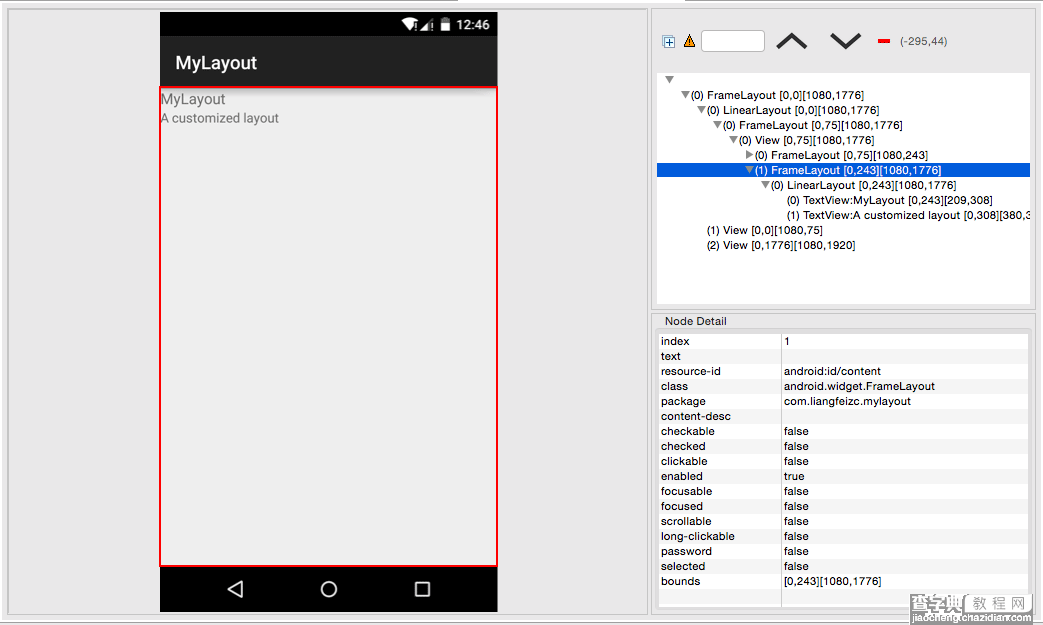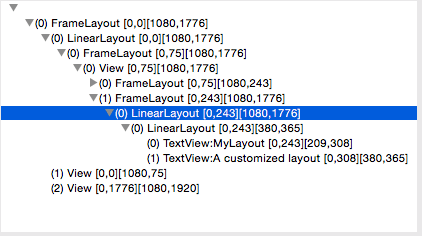本文实例讲述了Android中自定义一个View的方法。分享给大家供大家参考,具体如下:
Android中自定义View的实现比较简单,无非就是继承父类,然后重载方法,即便如此,在实际编码中难免会遇到一些坑,我把自己遇到的一些问题和解决方法总结一下,希望对广大码友们有所帮助。
注意点①用xml定义Layout时,Root element 最好使用merge
当我们需要继承一个布局比较复杂的ViewGroup(比较多的是LinearLayout、RelativeLayout)时,通常会用xml来写布局,然后在自定义的View类中inflate这个定义了layout的xml文件。
首先新建一个名为 MyLayout 的 class 文件,在 init 方法中解析稍后定义的xml文件。
/** * Created by liangfei on 4/14/15. */ public class MyLayout extends LinearLayout { public MyLayout(Context context) { super(context); init(); } private void init() { setOrientation(VERTICAL); View rootView = inflate(getContext(), R.layout.my_layout, this); ((TextView) rootView.findViewById(R.id.title)).setText("MyLayout"); ((TextView) rootView.findViewById(R.id.desc)).setText("A customized layout"); } }
然后新建一个取名为my_layout的布局文件, 并把 Root element 设置成merge。
<"1.0" encoding="utf-8"?> <merge xmlns:android="http://schemas.android.com/apk/res/android"> <TextView android:id="@+id/title" android:textSize="16sp" android:layout_width="wrap_content" android:layout_height="wrap_content" /> <TextView android:id="@+id/desc" android:layout_width="wrap_content" android:layout_height="wrap_content" /> </merge>
用 Android SDK 附带的 Monitor 工具查看一下运行时的布局信息。

最顶层是一个FrameLayout,然后是一个LinearLayout,里面有两个TextView,可以看出布局没有冗余。
但是,如果把 Root element 换成 LinearLayout,效果会怎么样呢?
<"1.0" encoding="utf-8"?> <LinearLayout xmlns:android="http://schemas.android.com/apk/res/android" android:orientation="vertical" android:layout_width="wrap_content" android:layout_height="wrap_content"> <TextView android:id="@+id/title" android:textSize="16sp" android:layout_width="wrap_content" android:layout_height="wrap_content" /> <TextView android:id="@+id/desc" android:layout_width="wrap_content" android:layout_height="wrap_content" /> </LinearLayout>

很明显,用 LinearLayout 做 Root element 后,布局多了一个层级,成了影响性能的一个因素。
注意点②重载子类构造函数时要弄清楚父类做了哪些操作
先从我一个惨痛的教训开始,当时我这样自定义了一个Button:
/** * Created by liangfei on 4/14/15. */ public class MyButton extends Button { public MyButton(Context context) { this(context, null); } public MyButton(Context context, AttributeSet attrs) { this(context, attrs, 0); } public MyButton(Context context, AttributeSet attrs, int defStyleAttr) { super(context, attrs, defStyleAttr); init(); } }
乍一看貌似没什么问题,构造函数的调用方式都是正确的,但是无论我怎么修改 MyButton 的属性,显示方式就是不正确。
其实问题就出在Button类在构造函数中使用了一个defStyleAttr, 而我这种写法会忽略掉这个defStyleAttr - com.android.internal.R.attr.buttonStyle,稍读源码就知道了。
@RemoteView public class Button extends TextView { public Button(Context context) { this(context, null); } public Button(Context context, AttributeSet attrs) { this(context, attrs, com.android.internal.R.attr.buttonStyle); } public Button(Context context, AttributeSet attrs, int defStyleAttr) { this(context, attrs, defStyleAttr, 0); } public Button(Context context, AttributeSet attrs, int defStyleAttr, int defStyleRes) { super(context, attrs, defStyleAttr, defStyleRes); } }
后来写代码的时候,我都是看了父类的源码之后才敢这么写,如果不确定就老老实实地写成下面这种形式。
/** * Created by liangfei on 4/14/15. */ public class MyButton extends Button { public MyButton(Context context) { super(context); init(); } public MyButton(Context context, AttributeSet attrs) { super(context, attrs); init(); } public MyButton(Context context, AttributeSet attrs, int defStyleAttr) { super(context, attrs, defStyleAttr); init(); } }
其实,还有很多其他的坑,比如 Button 的高度,后面抽时间再总结一下
希望本文所述对大家Android程序设计有所帮助。
【Android中自定义一个View的方法详解】相关文章:
★ android 自定义ScrollView实现背景图片伸缩的实现代码及思路
★ Android中 自定义数据绑定适配器BaseAdapter的方法
★ Android开发笔记之:在ImageView上绘制圆环的实现方法
★ Android定制RadioButton样式三种实现方法
★ Android开发笔记之:ListView刷新顺序的问题详解
